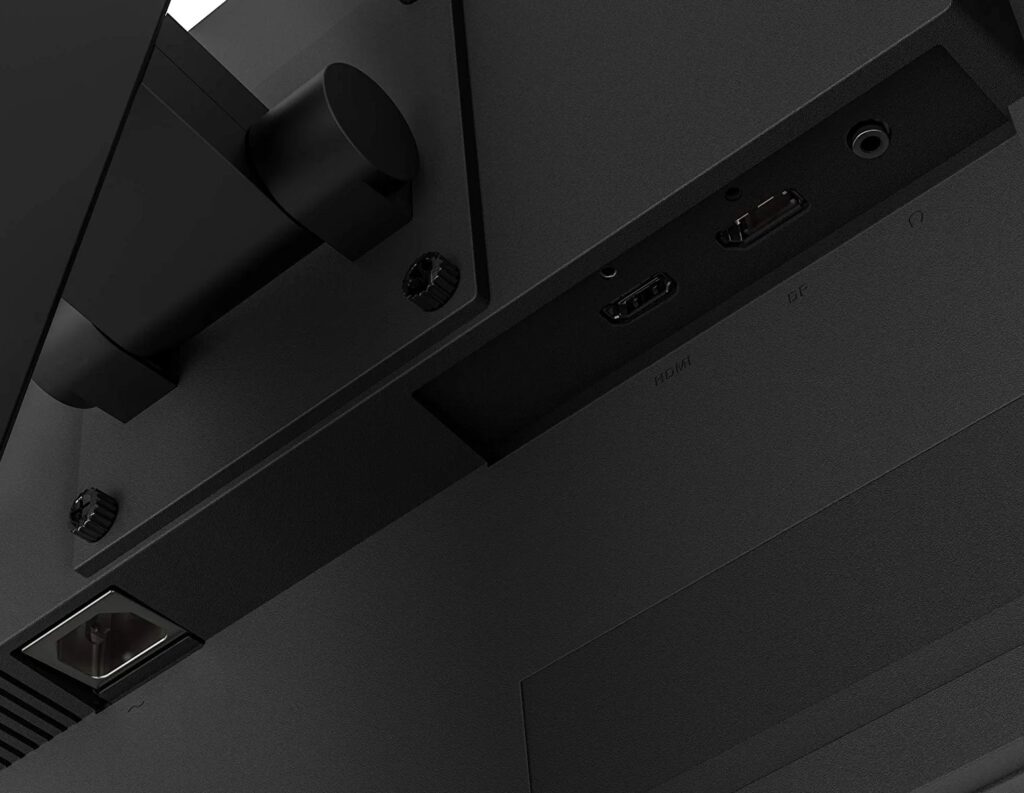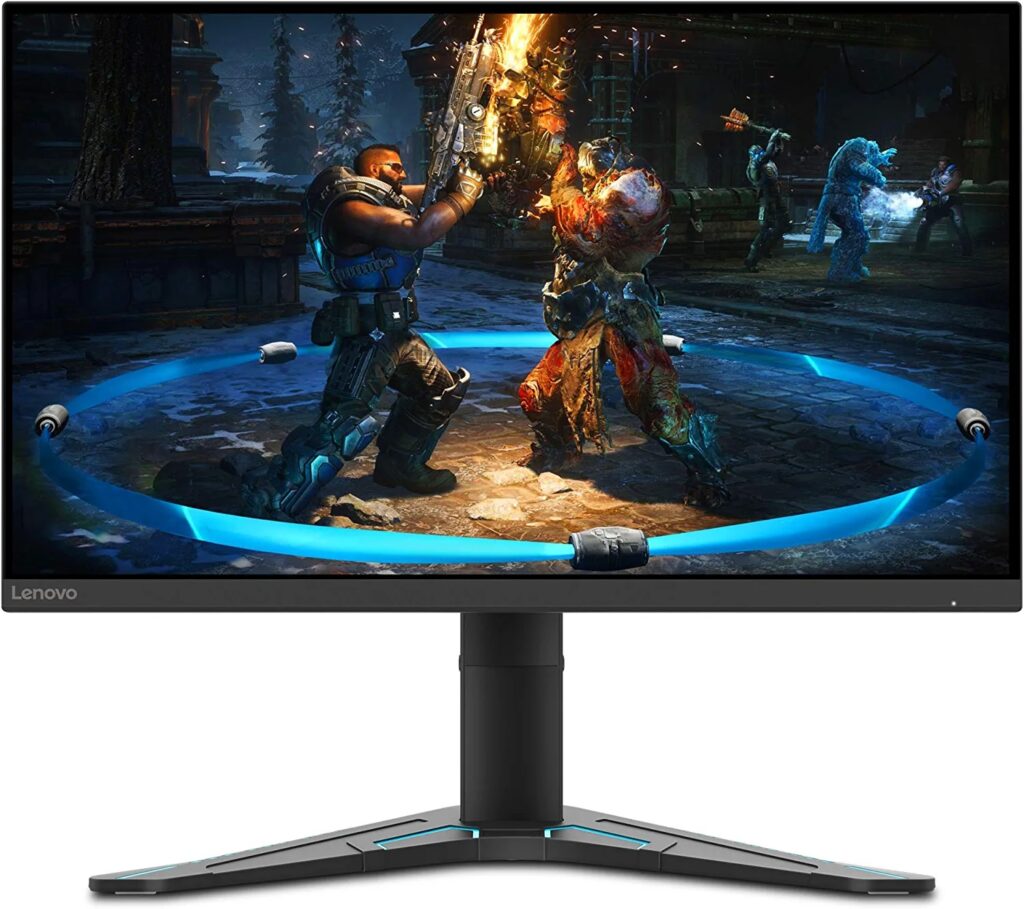The Lenovo G27q-20 is your best bet if you want to upgrade to a 1440p screen with a higher refresh rate for the least amount of cash. The downside is it’s limited to 100Hz, so it is obvious that it won’t be able to go toe to toe with the E-Sports models. Let’s take a closer look at the Lenovo G27q-20 to see if it’s worth your money and consideration.
Lenovo G27q-20 Specifications
- Screen Size: 27 Inches
- Resolution: 2560 x 1440 QHD
- Aspect Ratio: 16:9
- Panel Technology: In-Plane Switching (IPS)
- Refresh Rate: 100Hz
- Response Time: 3ms
- Contrast Ratio: 1000:1 (Static)
- Brightness: 400 cd/m²
- Speakers: None
- Stand: Height -Yes
- Stand: Tilt – Yes
- Stand: Swivel – No
- Stand: Pivot – No
- VESA Compatibility: Yes (100 x 100)
- Connectivity: HDMI 2.0 x 1, DisplayPort 1.2 x 1, 3.5mm Jack x 1
- Dimensions (W x H x D): 24.14” x 15.47” x 10.24”
- Weight: 13.76 lbs
Design and Features
The Lenovo G27q-20 isn’t as flashy as its Legion counterparts, although it has a large base with gamer-centric accents. The monitor has a matte black finish all over so it will fit in most settings or with most builds. It has a bezel-free design on the top and side edges but still has panel borders like any regular monitor.
It’s a 27-inch model, so it shouldn’t be too intrusive if you have a smaller than the standard desk. It does need a little over 10 inches of depth because of its large base, but it is still workable based on our experience. The whole device weighs 13.76 pounds so it is quite portable even if it’s slightly larger than the E-Sports standard.
The device has great build quality relative to its low price, so most users will be happy if they purchase it. The plastics used are thick and sturdy, plus there were no cosmetic defects on any of its parts. The included stand is decent, but its hinge feels a bit loose if you handle the cabinet or when it is nudged accidentally.
What’s annoying about the Lenovo G27q-20 is its OSD buttons that are cut out of the chassis instead of rubberized keys that protrude from it. The buttons feel harder to press, adding to the inconvenience of using more than one. However, this is understandable since this product is considerably cheaper than most offerings in the market.
The stand included with the package only offers tilt and height adjustments, but that’s usually enough for most situations. Most budget 1440p models are usually packaged this way, but some cheaper ones only have tilt stands. You can use VESA mounts if you need more flexibility, but that’s only necessary if you have multiple screens or a petite computer table. 
This model also doesn’t include a pair of speakers, but that’s fine for most budget options. Not a lot of brands and models have upgraded sets anyway, so this monitor will most likely have weak speakers if it did have them. We recommend using gaming headsets or speakers, which will be better for immersion.
Display and Performance
The Lenovo G27q-20 sports a 27-inch IPS panel with a 2560 x 1440 resolution, a 100Hz refresh rate, and a 3ms response time. Its backlight goes up to 400 cd/m2 while its contrast ratio is listed at 1000:1, like most IPS monitors. This model isn’t certified with VESA’s HDR standards but is compatible with HDR10 signals.
27-inch 1440p monitors are still popular because they are considered the sweet spot of this product category. They offer increased pixel count and clarity compared to 1080p but are not as sharp and demanding as a 4K alternative. It’s rather easy to reach 100 FPS with mid-tier GPUs now, so this option is a good candidate for a budget to midrange build.
The Lenovo G27q-20 covers 100% sRGB and 92% DCI-P3 so that it can show vibrant images in both games and movies. It’s also decently accurate out of the box with a deltaE average of only 1.89, so it is probably calibrated from the factory. Most users will be happy with the default settings to avoid the pesky OSD buttons.
Calibrating the monitor reduced the dE average to 1.08, making it usable for content creation and some editing. However, you will need a colorimeter since simply copying reviewers’ settings will not guarantee the same result. We recommend staying with the default setting or the monitor’s sRGB mode instead of spending more for a budget gaming model.
Its backlight reached a precise 401 cd/m2 at 100% while its contrast reached 1105:1 at 50% brightness. The monitor can fight off glare in well-lit rooms, but it’s incapable of deep blacks like VA or OLED monitors. It can only translate HDR signals but is not equipped to render them in the best way possible.
Panel uniformity for the Lenovo G27q-20 had some issues regarding panel uniformity. There were no massive backlight leaks or bleeding on the edges, but the backlight’s spread had some noticeable variances in different quadrants. It is most noticeable in dark scenes, but thankfully, not every G27q-20 will have this issue.
The Lenovo G27q-20 is decent when it comes to speed, but it clearly isn’t the fastest in the IPS gaming monitor category. It needs a bit of overdrive to clear up some visible trailing, but we can only recommend the Normal mode. The Extreme overdrive level clears up the persistence, but it adds overshoot which is worse than the original issue.
The Lenovo G27q-20 is compatible with both FreeSync and G-Sync, so you don’t have to worry about tearing and stuttering. Both GPU brands have 1440p-capable cards that are affordable, so it is important not to get stuck with either of them. Input lag sits at 6ms at 100Hz so its fast and responsive enough for any type of play.
Thoughts on the Lenovo G27q-20
The Lenovo G27q-20 is an excellent alternative if you want a budget monitor with a considerably better refresh rate than an office variant. It has decent build quality and a clean aesthetic, so it is still acceptable despite its limitations. Its IPS panel is capable of gorgeous colors and premium-grade accuracy, enabling the product to punch above its price point.
There are a few deal-breakers, starting with its peculiar 100Hz refresh rate. That will turn off most gamers since most will consider 144Hz to be the minimum. It’s also a bare monitor when it comes to extra features, so we can only recommend it as an entry-level choice and not a complete upgrade for seasoned gamers.
Pros:
- Low Price
- Superb Color Coverage and Accuracy
- Smooth and Responsive
Cons:
- Plenty of 144Hz+ Competition
- Limited Features




Leave a Reply